Biology
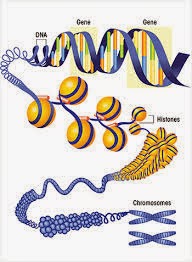 In the nucleus of each cell, the DNA molecule is packaged into thread-like structures called chromosomes. Each chromosome is made up of DNA tightly coiled many times around proteins called histones that support its structure.
In the nucleus of each cell, the DNA molecule is packaged into thread-like structures called chromosomes. Each chromosome is made up of DNA tightly coiled many times around proteins called histones that support its structure.
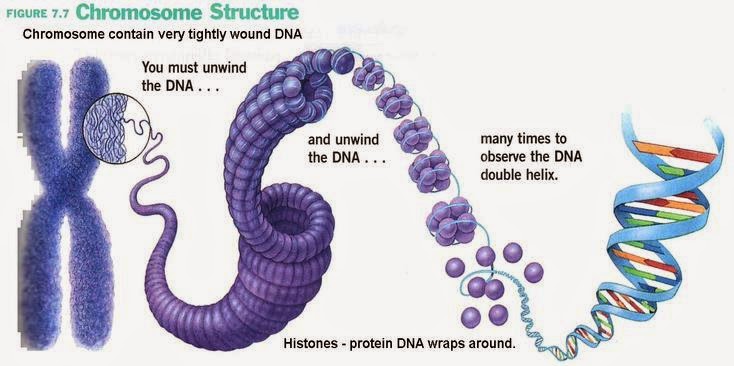
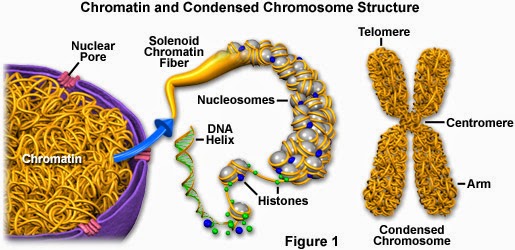
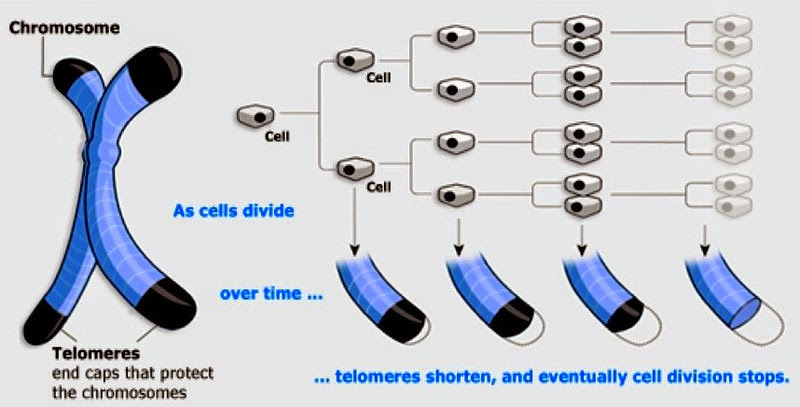
- Mitosis
Prophase Chromatin condenses to form chromosomes. Centrioles migrate to opposite poles of the cells (except in plant cells which do not have centrioles). Microtubules develop and form a star shaped structure known as an aster, and spindle fibres may develop....
- Q: Compare And Contrast The Prokaryotic And Eukaryotic Genomes
The eukaryotic genome is diploid but the prokaryotic genome is haploid. The eukaryotic genome has multiple origins of replication but the prokaryotic genome has only one origin of replication. The eukaryotic genome may have more than one chromosome but...
- Klinefelter's Syndrome Is Caused Due To The
A) absence of one of the X-chromosomes B) presence of additional copy of X-chromosome in males C) trisomy of chromosome number 21 D) presence of additional copy of X-chromosome in females The correct answer is: B) presence of additional copy of X-chromosome...
- What Is The Cause Of Turner's Syndrome?
A) Presence of additional copy of X-chromosome. B) Absence of one of the X-chromosomes C) Trisomy of chromosome number 21.D) None of these The correct answer is: B) Absence of one of the X-chromosomes...
- # 30 Mitosis
Mitosis is a nuclear division giving rise to genetically identical cells in which the chromosome number is maintained by the exact duplication of chromosome. Significance of mitosis production of geneticlly identical cells: It keeps the chromosome...
Biology
# 29 DNA structure


- Chromosomes are not visible in the cell?s nucleus?not even under a microscope?when the cell is not dividing. However, the DNA that makes up chromosomes becomes more tightly packed during cell division and is then visible under a microscope.

- Each chromosome has a constriction point called the centromere, which divides the chromosome into two sections, or ?arms.? The short arm of the chromosome is labeled the ?p arm.? The long arm of the chromosome is labeled the ?q arm.? The location of the centromere on each chromosome gives the chromosome its characteristic shape, and can be used to help describe the location of specific genes.
- A chromatid is 1 of the 2 identical strands of DNA that make uo a chromosome. 2 chromatids are joined by a centromere. Before replication, 1 chromosome is composed of 1 DNA molecule. Following S phase of interphase, each chromosome now composed of 2 DNA molecules (DNA replication ? the amount of DNA but does not ? the number of chromosomes.) The 2 identical copies are called chromatids. They are normaly identical (homozygous) but may have slight differences due to mutations (heterozygous).
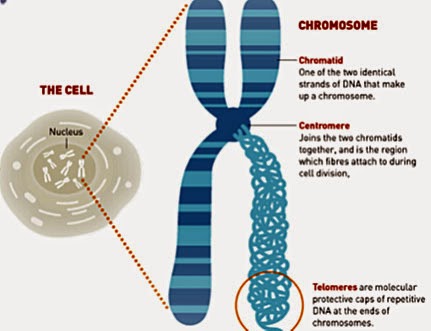 |
| Telomere is molecular protective cap of chromosomes. |
- Telomere is a region of repetitive nucleotide sequences at each end of a chromatid, which protects the end of the chromosome from deterioration or from fusion with neighbouring chromosomes. It is essential for maintaining the integrity and stability of linear eukaryotic genomes.
- During chromosome replication, the enzymes that duplicate DNA cannot continue their duplication all the way to the end of a chromosome, so in each duplication the end of the chromosome is shortened. The telomeres are disposable buffers at the ends of chromosomes which are truncated (shortened) during cell division; their presence protects the genes on the chromosome from being truncated instead.

- Telomere length regulation and maintenance contribute to normal human cellular aging and human diseases.
Syllabus 2016 5.1 Replication and division of nuclei and cells a) describe the structure of a chromosome, limited to DNA, histone proteins, chromatids, centromere and telomeres d) outline the significance of telomeres in permitting continued replication and preventing the loss of genes |
- Mitosis
Prophase Chromatin condenses to form chromosomes. Centrioles migrate to opposite poles of the cells (except in plant cells which do not have centrioles). Microtubules develop and form a star shaped structure known as an aster, and spindle fibres may develop....
- Q: Compare And Contrast The Prokaryotic And Eukaryotic Genomes
The eukaryotic genome is diploid but the prokaryotic genome is haploid. The eukaryotic genome has multiple origins of replication but the prokaryotic genome has only one origin of replication. The eukaryotic genome may have more than one chromosome but...
- Klinefelter's Syndrome Is Caused Due To The
A) absence of one of the X-chromosomes B) presence of additional copy of X-chromosome in males C) trisomy of chromosome number 21 D) presence of additional copy of X-chromosome in females The correct answer is: B) presence of additional copy of X-chromosome...
- What Is The Cause Of Turner's Syndrome?
A) Presence of additional copy of X-chromosome. B) Absence of one of the X-chromosomes C) Trisomy of chromosome number 21.D) None of these The correct answer is: B) Absence of one of the X-chromosomes...
- # 30 Mitosis
Mitosis is a nuclear division giving rise to genetically identical cells in which the chromosome number is maintained by the exact duplication of chromosome. Significance of mitosis production of geneticlly identical cells: It keeps the chromosome...
